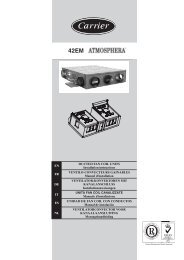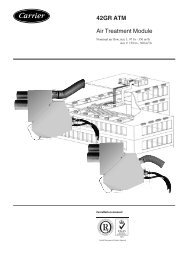19XR (PIC II) Hermetic Centrifugal Liquid Chillers 50 Hz - Carrier
19XR (PIC II) Hermetic Centrifugal Liquid Chillers 50 Hz - Carrier
19XR (PIC II) Hermetic Centrifugal Liquid Chillers 50 Hz - Carrier
Create successful ePaper yourself
Turn your PDF publications into a flip-book with our unique Google optimized e-Paper software.
h. Slowly raise the system pressure to a maximum of<br />
1103 kPa but no less than 241 kPa for HFC-134a by<br />
adding refrigerant. Proceed with the test for small<br />
leaks (Steps 3-9).<br />
3. Check the chiller carefully with an electronic leak<br />
detector, or soap bubble solution.<br />
4. Leak Determination - If an electronic leak detector indicates<br />
a leak, use a soap bubble solution, if possible, to<br />
confirm. Total all leak rates for the entire chiller.<br />
Leakage at rates greater than 0.45 kg/year for the<br />
entire chiller must be repaired. Note total chiller leak<br />
rate on the start-up report.<br />
5. If no leak is found during initial start-up procedures,<br />
complete the transfer of refrigerant gas from the<br />
pumpout storage tank to the chiller (see Pumpout and<br />
Refrigerant Transfer Procedures, <strong>Chillers</strong> with<br />
Pumpout Storage Tanks section (option).<br />
6. If no leak is found after a retest:<br />
a. Transfer the refrigerant to the pumpout storage tank<br />
and perform a standing vacuum test as outlined in the<br />
Standing Vacuum Test section, this page.<br />
b. If the chiller fails this test, check for large leaks (Step<br />
2b).<br />
c. Dehydrate the chiller if it passes the standing vacuum<br />
test. Follow the procedure in the Chiller Dehydration<br />
section. Charge chiller with refrigerant (see Pumpout<br />
and Refrigerant Transfer Procedures, <strong>Chillers</strong><br />
with Pumpout Storage Tanks section, Steps 1a-e).<br />
7. If a leak is found, pump the refrigerant back into the<br />
pumpout storage tank, or if isolation valves are present,<br />
pump into the non-leaking vessel (see Pumpout and<br />
Refrigerant Transfer procedures section).<br />
8. Transfer the refrigerant until chiller pressure is at 40<br />
kPa absolute.<br />
9. Repair the leak and repeat the procedure, beginning<br />
from Step 2h to ensure a leaktight repair. (If chiller is<br />
opened to the atmosphere for an extended period,<br />
evacuate it before repeating leak test.)<br />
10. The circuit openings must be plugged during repair, if<br />
this does not take longer than one day. If it takes<br />
longer, the circuits must be charged with nitrogen.<br />
4.3 - Standing Vacuum Test<br />
When performing the standing vacuum test or chiller dehydration,<br />
use a manometer or a wet bulb indicator. Dial gauges<br />
cannot indicate the small amount of acceptable leakage during<br />
a short period of time.<br />
1. Attach an absolute pressure manometer or wet bulb indicator<br />
to the chiller.<br />
2. Evacuate the vessel (see Pumpout and Refrigerant Transfer<br />
Procedures section) to at least 41 kPa, using a vacuum<br />
pump or the pumpout unit.<br />
3. Valve off the pump to hold the vacuum and record the<br />
manometer or indicator reading.<br />
4. a. If the leakage rate is less than 0.17 kPa in 24 hours,<br />
the chiller is sufficiently tight.<br />
b. If the leakage rate exceeds 0.17 kPa in 24 hours,<br />
repressurize the vessel and test for leaks. If refrigerant<br />
is available in the other vessel, pressurize by following<br />
Steps 2-10 of Return Refrigerant To Normal Operating<br />
Conditions section. If not, use nitrogen and a refrigerant<br />
tracer. Raise the vessel pressure in increments until<br />
the leak is detected. If refrigerant is used, the maximum<br />
gas pressure is approximately 483 kPa for HFC-134a<br />
at normal ambient temperature. If nitrogen is used,<br />
limit the leak test pressure to 1103 kPa maximum.<br />
5. Repair leak, retest, and proceed with dehydration.<br />
4.4 - Chiller Dehydration<br />
Dehydration is recommended if the chiller has been open for a<br />
considerable period of time, if the chiller is known to contain<br />
moisture, or if there has been a complete loss of chiller holding<br />
charge or refrigerant pressure.<br />
WARNING: Do not start or megohm-test the compressor motor<br />
or oil pump motor, even for a rotation check, if the chiller is<br />
under dehydration vacuum. Insulation breakdown and severe<br />
damage may result.<br />
Dehydration is readily accomplished at room temperatures.<br />
Use of a cold trap (Fig. 26) may substantially reduce the time<br />
required to complete the dehydration. The higher the room<br />
temperature, the faster dehydration takes place. At low room<br />
temperatures, a very deep vacuum is required for boiling off any<br />
moisture. If low ambient temperatures are involved, contact a<br />
qualified service representative for the dehydration techniques<br />
required.<br />
Perform dehydration as follows:<br />
1. Connect a high capacity vacuum pump (0.002 m 3 /s or<br />
larger is recommended) to the refrigerant charging valve<br />
(Fig. 2). Tubing from the pump to the chiller should be as<br />
short and as large a diameter as possible to provide least<br />
resistance to gas flow.<br />
2. Use an absolute pressure manometer or a wet bulb<br />
vacuum indicator to measure the vacuum. Open the<br />
shutoff valve to the vacuum indicator only when taking a<br />
reading. Leave the valve open for 3 minutes to allow the<br />
indicator vacuum to equalize with the chiller vacuum.<br />
3. Open all isolation valves (if present), if the entire chiller is<br />
to be dehydrated.<br />
4. With the chiller ambient temperature at 15.6°C or higher,<br />
operate the vacuum pump until the manometer reads<br />
-100.61 kPa or a vacuum indicator reads 1.7°C. Operate<br />
the pump an additional 2 hours.<br />
5. Do not apply greater vacuum than 100.96 kPa or go below<br />
0.56°C on the wet bulb vacuum indicator. At this<br />
tempera-ture/pressure, isolated pockets of moisture can turn<br />
into ice. The slow rate of evaporation (sublimination) of<br />
ice at these low temperatures/ pressures greatly increases<br />
dehydration time.<br />
41




